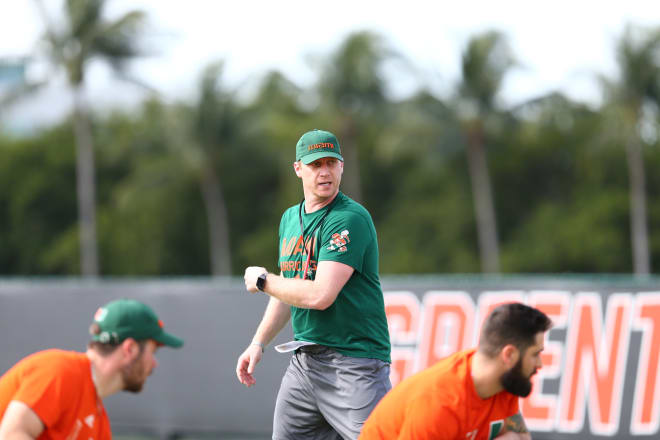STATE OF THE U 2020: Biggest on-field question

STATE OF THE U: 2021 class analysis
STATE OF THE U: 2020 class analysis
STATE OF THE U: 2019 class analysis
STATE OF THE U: 2018 class analysis
STATE OF THE U: 2017 class analysis
STATE OF THE U: 2016 class analysis
OPINION: Diaz attacked problems and State of the U should benefit
STATE OF THE U: Where does program stand in college football landscape?
The biggest on-field question entering 2020?
It's the impact Rhett Lashlee's new offense will make on the scoreboard.
If Lashlee's up-tempo spread attack led by Houston transfer QB D'Eriq King is anywhere close to the SMU attack that averaged 41.8 points and 489.8 yards last season, this Hurricanes team is poised for a double-digit win season.
If it's closer to the 25.7 points and 367.2 yards UM averaged in 2019? Well Miami fans don't want to think about that.
In NCAA ranking terms it looked like this:
* SMU was No. 9 in the nation in total offense; Miami was 98th.
* SMU was No. 7 in average points scored; Miami was 90th.
Obviously Miami's competition was probably tougher, but you get the idea.
With that said, while Lashlee's offensive style has major pros, it also could have some cons and it all won't be defined until a season plays out.
The pros, of course, are the common belief that the attacking style better suits the Canes' talent (and recruits love it), allowing players to line up without overthinking things and quickly run plays to keep the defense on its heels.
The negative: If the offense falters with a lot of three-and-outs or nonproductive series that puts a tremendous amount of pressure on a defense that isn't deep and has major question marks at linebacker and cornerback. You do not want your defense on the field the majority of the time if the offense is flaming out in less than a minute on consecutive series, for instance. And here is another legit question. If things aren't going well in a game, which they inevitably will at times, will defensive-minded coach Manny Diaz want to slow things down for Lashlee's attack to give the D a breather?
To give an idea of what might come, SMU's opponents ran an average of 77.8 plays per games last season.
Miami? Opponents averaged 65.3 plays per game vs. the Cane D.
So that's an average of a couple of extra series per game the UM defense is likely to be on the field in 2020.
All of the above is why this really is the biggest question for the team. Because if Lashlee's group succeeds ... or doesn't .... will have the biggest impact on wins and losses. And if it were a slam dunk on face value, wouldn't every team in football run the up-tempo spread?
Another way to look at this: In 2019 UM was, we can all agree, not good. But the team's first five losses were all by a touchdown or less. A more high-powered offense could have had a vast impact on that. And, by the same token, maybe if Miami had won those games, the final two losses don't go the same way this down-in-the-dumps team saw it go with the losses by double digits to Duke and Louisiana Tech.
A lot will have to do with whether Miami gets elite play at the quarterback position. D'Eriq King has a ton going for him - athleticism, that 50 TD performance at Houston in 2018 - but missing spring ball will set an offense that was just getting installed back compared to teams that are running the same system as 2019.
This is the simple fact: Without consistent play at QB, this team simply won't reach its goals. And while optimism always reigns supreme in the preseason, we should also point out the issue with completion percentage. Teams usually want close to 70 percent for an elite level (Joe Burrow, for example, hit 76.3 percent of his throws last season). Miami the last two years has sat at below 60 percent (the team's 58.4 completion percentage in 2019 ranked No. 83 in the nation).
King?
He has a completion percentage line that reads 64.7 percent in 2017, 63.5 percent in 2018 and 52.7 percent last season in his four games started.
Now, any of his accuracy issues are more than offset by his running ability. But at the end of the day Lashlee's offense will only click on all cylinders if the passing game makes opponents respect it to the point they're not constantly shadowing King and trying to thwart the run game.
The tight ends, wide receivers and running backs have talent.
The O line is a major question mark after allowing 51 sacks.
So Lashlee has to, from the four spring practices, figure out a strategy for when the team reconvenes on the practice field.
He has to mesh it all together.
And make it work.
If he can do that, the new offense can be the difference between another six-win season or a double-digit victory campaign.